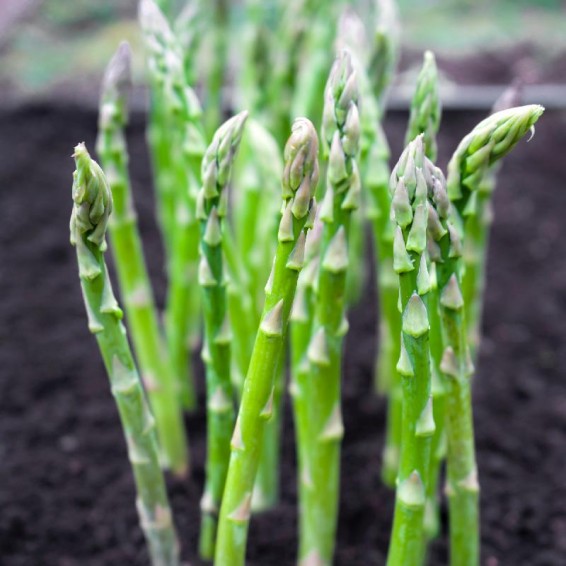Organic Mary Washington Asparagus Seeds
Asparagus officinalis
- HOW TO GROW
- FAST FACTS
HOW TO GROW
Sowing: Soak seeds overnight to weaken the hard outer layer, then plant 1/4" deep and 2" apart in a temporary nursery bed. Keep the temperature at 70-80 degrees F, and germination should begin in 10-14 days. For direct sowing, plant the seeds after the last frost of spring. For greater garden benefits, plant your asparagus and tomatoes in close proximity; these two greatly benefit each other.
Growing: About 10-12 weeks after planting, transplant the seedlings outdoors. Digging a trench is not necessary; simply place the plants 12" apart in rows 3-4' apart. Sandy, well drained soil, and full sun are ideal. Keep the soil moist, and apply mulch to discourage weeds. Asparagus greatly benefits from regular additions of compost and other organic matter.
Harvesting: Asparagus can be harvested in the second year, but healthier roots develop when serious harvesting begins in the third year. Spears may be harvested as soon as they appear in the spring until early summer; a height of 8" is usually the optimum size. Rather than cutting the spears, bending them until they break gives you only the tender part of the spear. When the weather gets hot, it is best to let the spears fully develop with ferny tops to ensure a healthy crop the next year.
Seed Saving: Though a well established plot of asparagus will last for 20 years or more, the seeds can be saved if necessary. The stalks should be allowed to reach their mature state, when they are tall and fern-like. When the berries of the female plant turn red, pick them and squeeze out the seeds into a container of water; carefully clean off any remaining pulp. Lay them out to dry for several weeks before storing them. Keep them in a cool, dry place for up to three years.
FAST FACTS
Latin Name: Asparagus officinalis
Species Origin: Heirloom from 1935
Type: Open Pollinated, Heirloom, Cool Season|Warm Season
Life Cycle: Perennial
USDA Zones: 3, 4, 5, 6, 7, 8, 9, 10, 11, 12
Seeds per Ounce: 600
Seeds for 100' Row: 1/2 Oz
Seeds for 1 Acre: 3 Lbs
Planting Method: From Transplant
Germination Temp: 65F-80F
Germination Days: 10-14 Days
Planting Depth: 0.25
Planting Spacing: 12
Row Spacing: 32
Days to Maturity: 365
Sunlight: Full Sun
Height: 60 Inches
Color: Green
Diseases: Rust, Blight
DESCRIPTION
HOW TO GROW
Sowing: Soak seeds overnight to weaken the hard outer layer, then plant 1/4" deep and 2" apart in a temporary nursery bed. Keep the temperature at 70-80 degrees F, and germination should begin in 10-14 days. For direct sowing, plant the seeds after the last frost of spring. For greater garden benefits, plant your asparagus and tomatoes in close proximity; these two greatly benefit each other.
Growing: About 10-12 weeks after planting, transplant the seedlings outdoors. Digging a trench is not necessary; simply place the plants 12" apart in rows 3-4' apart. Sandy, well drained soil, and full sun are ideal. Keep the soil moist, and apply mulch to discourage weeds. Asparagus greatly benefits from regular additions of compost and other organic matter.
Harvesting: Asparagus can be harvested in the second year, but healthier roots develop when serious harvesting begins in the third year. Spears may be harvested as soon as they appear in the spring until early summer; a height of 8" is usually the optimum size. Rather than cutting the spears, bending them until they break gives you only the tender part of the spear. When the weather gets hot, it is best to let the spears fully develop with ferny tops to ensure a healthy crop the next year.
Seed Saving: Though a well established plot of asparagus will last for 20 years or more, the seeds can be saved if necessary. The stalks should be allowed to reach their mature state, when they are tall and fern-like. When the berries of the female plant turn red, pick them and squeeze out the seeds into a container of water; carefully clean off any remaining pulp. Lay them out to dry for several weeks before storing them. Keep them in a cool, dry place for up to three years.
FAST FACTS
Latin Name: Asparagus officinalis
Species Origin: Heirloom from 1935
Type: Open Pollinated, Heirloom, Cool Season|Warm Season
Life Cycle: Perennial
USDA Zones: 3, 4, 5, 6, 7, 8, 9, 10, 11, 12
Seeds per Ounce: 600
Seeds for 100' Row: 1/2 Oz
Seeds for 1 Acre: 3 Lbs
Planting Method: From Transplant
Germination Temp: 65F-80F
Germination Days: 10-14 Days
Planting Depth: 0.25
Planting Spacing: 12
Row Spacing: 32
Days to Maturity: 365
Sunlight: Full Sun
Height: 60 Inches
Color: Green
Diseases: Rust, Blight






